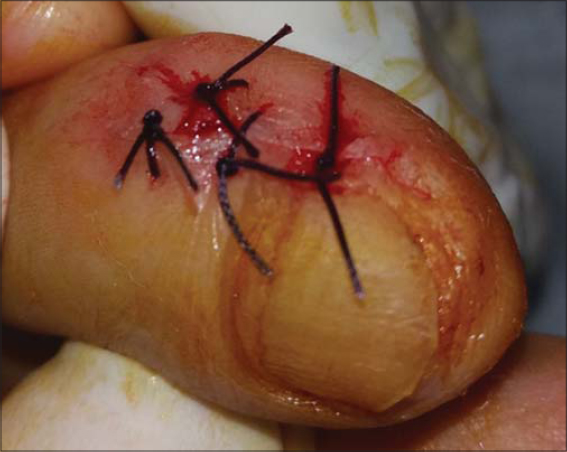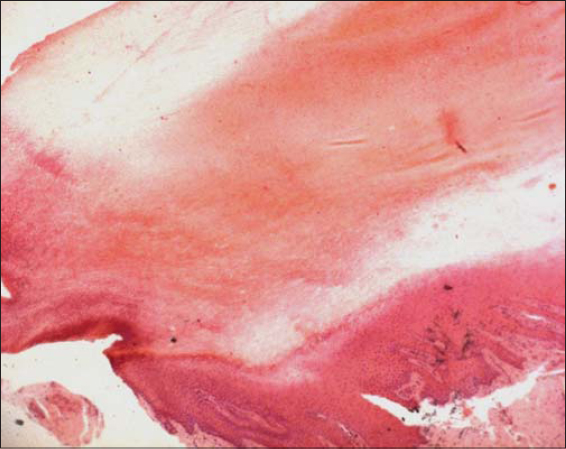A case of post-traumatic ectopic nail in an adult female patient
Nadia Nabli , Rima Gammoudi, Mohamed Denguezli
, Rima Gammoudi, Mohamed Denguezli
Department of Dermatology; Farhat Hached University Hospital, Sousse, Tunisia
Corresponding author: Dr. Nadia Nabli
Submission: 02.04.2020; Acceptance: 24.06.2020
DOI: 10.7241/ourd.2020e.116
Cite this article: Nabli N, Gammoudi R, Denguezli M. A case of post-traumatic ectopic nail in an adult female patient. Our Dermatol Online. 2020;11(e):e116.1-e116.2.
Citation tools:
Copyright information
© Our Dermatology Online 2020. No commercial re-use. See rights and permissions. Published by Our Dermatology Online.
A 53-year-old female presented to us with complaint of pain over the left fourth toe. It had its onset after sustaining trauma at the site five years ago. Three months following the trauma, she noticed a nail-like outgrowth projecting over the nail of the left fourth toe, which was growing at the same speed as the underlying nail. Physical examination showed a solitary, well defined nail on the top of the normal nail arising from the eponychium (Fig. 1). X-ray of the affected finger didn’t reveal polydactyly or any bone abnormality. With a diagnosis of ectopic nail, complete excision of the nail with its germinal matrix was planned (Fig. 2). Histopathological examination revealed a well-formed nail with germinal matrix without a granular layer (Fig. 3).
Ectopic nail or Onychoheterotopia is an extremely rare disorder, in which the nail tissue grows outside the classic nail unit of the dorsal fingers and toes. It may either be congenital or acquired. Acquired ectopic nail is usually an outcome of trauma to the nail unit which may in turn result in transfer of inoculation of the nail matrix, causing the ectopic nail growth. it is usually asymptomatic but it can be associated with pain, pruritus and swelling. Histopathological diagnosis is based upon the presence of a fully developed nail unit, including a corneous nail plate and nail matrix. Regardless of the type, the standard treatment of ectopic nail is total surgical excision of the nail unit including the nail matrix.
In conclusion, ectopic nail is a rare condition that is easily managed through surgical excision. Although it is uncommon, knowledge of its clinical manifestations will assure proper diagnosis and management.
Consent
The examination of the patient was conducted according to the Declaration of Helsinki principles.
The authors certify that they have obtained all appropriate patient consent forms. In the form the patient(s) has/have given his/her/their consent for his/her/their images and other clinical information to be reported in the journal. The patients understand that their names and initials will not be published and due efforts will be made to conceal their identity, but anonymity cannot be guaranteed.
Notes
Source of Support: Nil,
Conflict of Interest: None declared.
Request permissions
If you wish to reuse any or all of this article please use the e-mail (brzezoo77@yahoo.com) to contact with publisher.
| Related Articles | Search Authors in |
|
 http://orcid.org/0000-0002-1367-1423 http://orcid.org/0000-0002-1367-1423 |






Comments are closed.